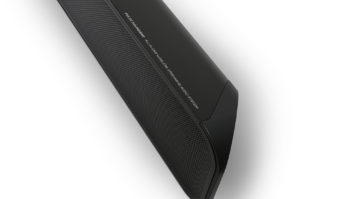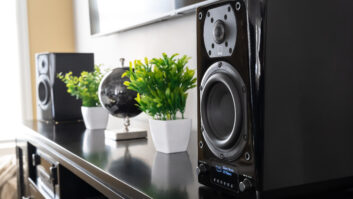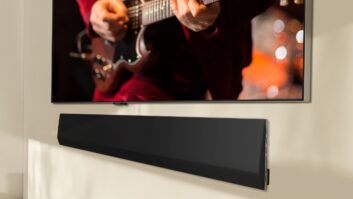A mainstream speaker company can’t really claim to be in the audio game anymore without having at least one soundbar in their lineup. The soundbar is the audio industry’s acknowledgement that flat panel TVs come with garbage sound quality while also conceding that not every room in the home is a candidate for a traditional audio system.
From a custom integration standpoint, the soundbar also opens up nearly every room in the home to a quick and easy potential add-on sale. Whereas someone might not want another stack of electronics, spend thousands on multiple speakers, or have another day of labor added to the bill, they very well might be willing to willing to invest in a soundbar as an upgraded audio solution.

Bluesound offers the rather ingenious TS100 universal tabletop TV stand, which supports both a flat-panel TV and the bar.
When I heard Bluesound was launching the new Pulse Soundbar and Subwoofer to join its wireless house-wide family of products, I knew it was going to be a winner. I’ll admit to being an unabashed Bluesound fan, having reviewed the system on two previous occasions. Not only has the Bluesound ecosystem been built for high-res audio capability from the ground up by a company with a decidedly audiophile background, but it also features one of the best control apps on the market. Bluesound also has integration drivers for Control4 and RTI, with support just announced for Crestron SIMPL and Push, with a URC driver expected this spring. I’ve said it before, but it bears repeating: the best sounding audio system in the world is next to useless if the end user can’t make it work or it isn’t enjoyable to use. Bluesound kills it on this front.
While the Pulse Soundbar and Sub can absolutely be used on their own–as I did in this review–they can also seamlessly join Bluesound’s family of products. This includes the Pulse Flex, Pulse Mini, and Pulse 2 wireless speakers, and the preamp Node 2, amplified Power Node 2, and Vault 2, one of the most distinctive products out there in the wireless multiroom space. Up to 16 products can run simultaneously in a strictly Wi-Fi environment, with up to 64 capable when connected via Ethernet. This means Bluesound can easily fit into virtually any audio distribution system, regardless of how large or high end.
The Pulse Soundbar offers the usual options of tabletop or wall mounting via the included bracket. With the bar’s 5.5-inch height, it’s possible that it will intrude on the bottom of the screen if sitting on a tabletop. To resolve this, Bluesound offers the rather ingenious TS100 universal tabletop TV stand, which supports both a flat panel TV and the bar.
To get a sense of what the Pulse Bar could do, I spent a good bit of time listening to it solo before pairing it with the sub. I was immediately impressed with the clarity and detail of the audio; voices were distinct and easy to understand, with instruments clearly presented and defined. While a soundbar’s principal goal in life may be improving TV sound, Bluesound delivered a bar that performs beautifully with music as well.
Bluesound has steadily added music services to its resume, and the system now supports biggies like TuneIn Radio, iHeartRadio, Spotify, TIDAL, and Napster. The omissions of Pandora and Sirius/XM will be a bummer to some, but with Bluetooth aptX support, you can easily stream your favorite content directly to the Soundbar.

The Pulse Soundbar offers the usual options of tabletop or wall mounting via the included bracket.
Of far more interest to audiophiles is the Soundbar’s world’s-first support of MQA (Master Quality Authenticated) audio. While a complete description of MQA is well beyond the scope of this review, suffice it to say, MQA is designed to deliver high-res audio in a package small enough to stream, delivering “every nuance, every subtlety, every tiny drop of emotion…to your ears.” With TIDAL currently offering hundreds of MQA-encoded albums (and many more planned) there’s a ton of music to experience, including Talking Heads, John Coltrane, and Van Morrison. The MQA streams indeed sounded terrific, revealing an extra layer of detail and dimensionality to the music, and through hours of listening, I never felt like the Soundbar was delivering a compromised experience.
Probably most unexpected was the bar’s tremendous low-end response. Whether it was jazzy standing bass notes, synth drum beats, The Blue Man Group’s driving percussion, or the rumble of an Imperial Star Destroyer, the bar produced palpable low end. At only 3dB down at 55Hz, this bar has the chops to deliver full-range sound without a sub in many rooms.
Of course, adding the Pulse Subwoofer delivered that lowest octave of bottom-end performance, giving weight to the audio and really bringing movies and music to life. And if I was surprised by the bass the bar produced, I was shocked by the low-end that this tiny sub pumped out. The Sub’s incredibly thin profile lends itself to a lot of creative placement options in a room, including wall mounting with the provided bracket. While you could use any subwoofer with the Pulse Soundbar’s RCA output, the wireless pairing between Pulse Bar and Sub is natural, and it’s clear that much thought has been put into the sonic integration between the two.
I loved that the app offered three audio presets labeled TV, Music, and Movies. These are all independently adjustable, letting you tweak things like width, dialog enhancement, late night compression, bass, treble, and subwoofer levels for each. This lets users quickly dial in to their preferred listening modes for each.
With music listening and all processing turned off, the bar delivered a fairly wide stereo image, performing like a pair of bookshelf speakers sitting about eight feet apart. With Wide Mode to its widest setting on movies, the bar threw images well outside its width.

The Pulse Subwoofer delivered that lowest octave of bottom-end performance, giving weight to the audio and really bringing movies and music to life.
In a great scene from Star Wars: The Force Awakens, Poe walks past the blaster bolt that Kylo Ren has frozen. You hear that crackling of the energy shift from far left of the screen, travel to center, then shift to far right as he walks past the bolt. In Mad Max: Fury Road, the dreamy, “Where are you?” voices in the opening scene remained clearly understandable while swirling around the sides of the room. The bar also did a great job of expanding the crowd noise from this year’s Super Bowl LI, while still keeping the announcers clear and understandable.
While the bar produces a wide and enjoyable soundstage, as a 2.1 system it doesn’t offer as much surround envelopment as I’ve experienced from other bars. Bluesound, however, said that they are planning to offer the ability to add surround speakers to the bar via an update later this year, so that should complete the surround experience.
At a buck shy of $1,000, the Pulse Soundbar sits at the upper end of soundbar pricing, especially since it doesn’t come with a sub. For that price you’d be right to expect a good deal of performance, and rest assured, Bluesound delivers in spades. Add in the Pulse Sub and you get a complete listening experience for under $1,600 that not only shines on whatever you’re listening to, but is also a gateway to Bluesound’s terrific house-wide audio system.
855.531.4666
bluesound.com
Kudos
Terrific Bluesound interface; MQA audio playback; stellar audio performance
Concerns
Not as “surrounding” as some bars; no Pandora or Sirius/XM support
Product Specs
Pulse Soundbar:
► Handles MP3, AAC, WMA, OGG, WMA-L, ALAC, OPUS, FLAC, MQA, WAV, AIFF files up to 192/24 quality; Dolby Digital decoding; Bluetooth aptX
► System supports up to 64 players, maximum 16 connected via WiFi 802.1 b/g/n
► Tri-amplified DirectDigital Amplifier: 120 watts total power driving 2 x 100mm woofers, 2 x 100mm passive radiators, 2 x 50mm midrange, 2 x 25mm tweeters
► Inputs: analog audio, Toslink digital, Gigabit Ethernet RJ45, USB Type-A, USB Type-B (service only); Outputs: RCA subwoofer; detachable power cable
Pulse Subwoofer:
► 6.5 inch polypropylene cone
► Class D amplifier; 100 watts continuous, 200 watts dynamic peak
► Wirelessly connects to Pulse Soundbar; also features RCA line level and LFE inputs and outputs







